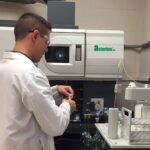INDIANAPOLIS, September 19, 2016 – Asterion, LLC announced today the launch of a sample analysis submission process for the company’s proprietary plating and pretreatment chemistries. Designed to ensure ease-of-use and quick customer response, the submission process meets growing customer requirements to optimize plating line efficiency and productivity at a low cost of ownership. Customers may submit up to ten sample requests per submission. Every sample is assigned an identifier number for testing at Asterion’s advanced analytical laboratory. Furthermore, free sample submission kits … [Read more...]
Removing Sand Residue from Casted Parts: Cleaner Selection Is Critical
Surface finishers are continually challenged with selecting the right cleaners to remove sand residue on casted parts. The main reason for this is that sand --- typically a silicon-based compound--- is insoluble in water, which causes the detergency of the cleaners to be lost. Detergency is what allows the cleaners to pull soils into the solution and remove them from the part’s surface. The sand (or silicon) itself does not affect the detergency of the cleaner; it simply isn’t acted upon by it. With sand residue, good solution movement is critical, as you must rely on mechanical forces to … [Read more...]
Blair Vandivier Bestowed the Distinction of Fellow by the NASF
INDIANAPOLIS, August 16, 2016 – Mr. Blair Vandivier, President and CEO of Asterion, LLC was recently bestowed the distinction of Fellow by the National Association for Surface Finishing (NASF). The honor recognizes those NASF members that have made significant and lasting contributions through their leadership and dedicated service to the association and the surface finishing industry. An industry veteran, Vandivier has been previously recognized by his peers, while earning the respect of his customers and competitors over a career that spans more than thirty years. Prior to being honored … [Read more...]
Filtration, Carbon Treatment and Maintenance of Plating Baths
By Doug Trageser In our most recent series “Water and the Plating Process”, we focused on how water quality can affect the plating process starting with cleaners and rinses all the way to the final finish. As an experienced finisher knows, even with “clean” water ahead of the plating system, the plating baths need regular cleaning in order to maintain high-quality finishes and a steady state operation. Filtration Arguably, the most important detail to keeping a plating line clean is filtration. A lack of good filtration can lead to many issues, such as shelf roughness, pitting and … [Read more...]
Carbonates in the Plating Bath
If you have an alkaline plating bath, then you are likely familiar with carbonates. Those of you who still have or have had cyanide plating baths are all too familiar with carbonates. In this article, we will discuss what a carbonate is, how it is formed in a plating solution, and what it does to the plating bath. We will also visit a couple of ways of dealing with these when they get too high. What Is a Carbonate? First things first, what is a carbonate? A carbonate is a salt of the anion CO32-. That’s all well and good for those of us who stayed awake in chemistry, but for the rest of us, … [Read more...]
Water and the Plating Process: Part 3
As we have discussed in part 1 and part 2 of this series, water is very important to the plating process. As an astute reader will recall, we are discussing how different types of water will affect the plating process. This week, we will wrap up the discussion with Purified Water. Purified Water Purified water, such as RO or DI water, will contain few to zero ions. Thus, it is very different from soft or hard water in how it relates to cleaner baths. Since there is a dearth of stuff in solution, purified water will not inhibit saponification. Purified water will also not increase the amount … [Read more...]
Water and the Plating Process : Part 2
In the first part of this three-part series, we discussed water and the integral part it plays in the plating process. We are talking about how the different types of water impact the plating process in different ways. In this post, we will talk about soft water and how it affects different process tanks. Soft Water Soft water, much like hard water, contains cations. However, these cations are different from hard water cations. Soft water typically contains Na+ (Sodium) and K+ (Potassium) rather than Ca2+ (Calcium) and Mg2+ (Magnesium). Let’s take a look at how these different cations affect … [Read more...]
Water and the Plating Process: Part 1
It may seem fairly obvious to most readers, but water plays an integral role in the plating process. Whether it’s the rinse tanks, or the process tanks, water is in every bath. It may come as no surprise to you that the different types of water will interact with the plating process in different ways. In this series of blog posts, we will delve into each type of water and how it interacts with the process, starting with hard water. Hard Water As you may recall, hard water is characterized by its mineral content. These minerals, typically calcium and magnesium, can cause several issues. Let’s … [Read more...]
Bright Nickel Chrome Plating
Nickel is plated for many reasons. The appearance can be altered by modifying the nickel deposit itself or the thin chrome coating over it to produce bright, satin, or dark finishes. First and foremost, we tend to think of nickel as a bright finish. Nickel provides a decorative appearance due to its ability to cover imperfections in the basis metal (leveling). Nickel deposits can be made brilliant and when covered by a thin layer of decorative chromium, will maintain its brilliance even under severe conditions. Satin Nickel Satin nickel under bright or dark chromium offers a wide range of … [Read more...]

